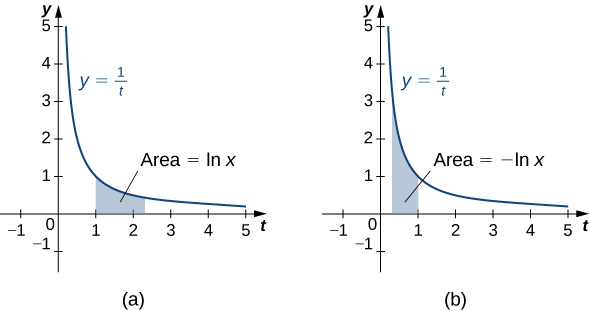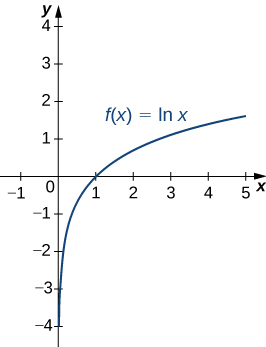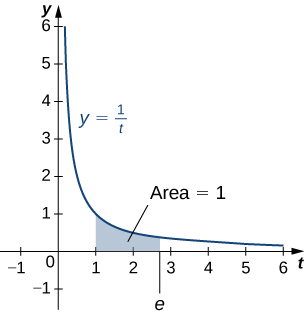Learning Outcomes
- Write the definition of the natural logarithm as an integral
- Recognize the derivative of the natural logarithm
- Integrate functions involving the natural logarithmic function
- Define the number 𝑒 through an integral
The Natural Logarithm as an Integral
Recall the power rule for integrals:
Clearly, this does not work when [latex]n=-1,[/latex] as it would force us to divide by zero. So, what do we do with [latex]\displaystyle\int \frac{1}{x}dx?[/latex] Recall from the Fundamental Theorem of Calculus that [latex]{\displaystyle\int }_{1}^{x}\dfrac{1}{t}dt[/latex] is an antiderivative of [latex]\frac{1}{x}.[/latex] Therefore, we can make the following definition.
Definition
For [latex]x>0,[/latex] define the natural logarithm function by
For [latex]x>1,[/latex] this is just the area under the curve [latex]y=1\text{/}t[/latex] from 1 to [latex]x.[/latex] For [latex]x<1,[/latex] we have [latex]{\displaystyle\int }_{1}^{x}\frac{1}{t}dt=\text{−}{\displaystyle\int }_{x}^{1}\frac{1}{t}dt,[/latex] so in this case it is the negative of the area under the curve from [latex]x\text{ to }1[/latex] (see the following figure).

Figure 1. (a) When [latex]x>1,[/latex] the natural logarithm is the area under the curve [latex]y=\frac{1}{t}[/latex] from [latex]1\text{ to }x.[/latex] (b) When [latex]x<1,[/latex] the natural logarithm is the negative of the area under the curve from [latex]x[/latex] to 1.
Notice that [latex]\text{ln}1=0.[/latex] Furthermore, the function [latex]y=\frac{1}{t}>0[/latex] for [latex]x>0.[/latex] Therefore, by the properties of integrals, it is clear that [latex]\text{ln}x[/latex] is increasing for [latex]x>0.[/latex]
Properties of the Natural Logarithm
Because of the way we defined the natural logarithm, the following differentiation formula falls out immediately as a result of to the Fundamental Theorem of Calculus.
Derivative of the Natural Logarithm
For [latex]x>0,[/latex] the derivative of the natural logarithm is given by
Corollary to the Derivative of the Natural Logarithm
The function [latex]\text{ln}x[/latex] is differentiable; therefore, it is continuous.
A graph of [latex]\text{ln}x[/latex] is shown in Figure 2. Notice that it is continuous throughout its domain of [latex](0,\infty ).[/latex]

Figure 2. The graph of [latex]f(x)=\text{ln}x[/latex] shows that it is a continuous function.
Example: Calculating Derivatives of Natural Logarithms
Calculate the following derivatives:
- [latex]\frac{d}{dx}\text{ln}(5{x}^{3}-2)[/latex]
- [latex]\frac{d}{dx}{(\text{ln}(3x))}^{2}[/latex]
Try It
Calculate the following derivatives:
- [latex]\frac{d}{dx}\text{ln}(2{x}^{2}+x)[/latex]
- [latex]\frac{d}{dx}{(\text{ln}({x}^{3}))}^{2}[/latex]
Watch the following video to see the worked solution to the above Try It.
Try It
Note that if we use the absolute value function and create a new function [latex]\text{ln}|x|,[/latex] we can extend the domain of the natural logarithm to include [latex]x<0.[/latex] Then [latex](d\text{/}(dx))\text{ln}|x|=1\text{/}x.[/latex] This gives rise to the familiar integration formula.
Integral of (1/[latex]u[/latex]) du
The natural logarithm is the antiderivative of the function [latex]f(u)=1\text{/}u\text{:}[/latex]
Example: Calculating Integrals Involving Natural Logarithms
Calculate the integral [latex]\displaystyle\int \frac{x}{{x}^{2}+4}dx.[/latex]
Try It
Calculate the integral [latex]\displaystyle\int \frac{{x}^{2}}{{x}^{3}+6}dx.[/latex]
Watch the following video to see the worked solution to the above Try It.
Try It
Although we have called our function a “logarithm,” we have not actually proved that any of the properties of logarithms hold for this function. We do so here.
Properties of the Natural Logarithm
If [latex]a,b>0[/latex] and [latex]r[/latex] is a rational number, then
- [latex]\text{ln}1=0[/latex]
- [latex]\text{ln}(ab)=\text{ln}a+\text{ln}b[/latex]
- [latex]\text{ln}(\frac{a}{b})=\text{ln}a-\text{ln}b[/latex]
- [latex]\text{ln}({a}^{r})=r\text{ln}a[/latex]
Proof
- By definition, [latex]\text{ln}1={\displaystyle\int }_{1}^{1}\frac{1}{t}dt=0.[/latex]
- We have
[latex]\text{ln}(ab)={\displaystyle\int }_{1}^{ab}\frac{1}{t}dt={\displaystyle\int }_{1}^{a}\frac{1}{t}dt+{\displaystyle\int }_{a}^{ab}\frac{1}{t}dt.[/latex]
Use [latex]u\text{-substitution}[/latex] on the last integral in this expression. Let [latex]u=t\text{/}a.[/latex] Then [latex]du=(1\text{/}a)dt.[/latex] Furthermore, when [latex]t=a,u=1,[/latex] and when [latex]t=ab,u=b.[/latex] So we get
[latex]\text{ln}(ab)={\displaystyle\int }_{1}^{a}\frac{1}{t}dt+{\displaystyle\int }_{a}^{ab}\frac{1}{t}dt={\displaystyle\int }_{1}^{a}\frac{1}{t}dt+{\displaystyle\int }_{1}^{ab}\frac{a}{t}·\frac{1}{a}dt={\displaystyle\int }_{1}^{a}\frac{1}{t}dt+{\displaystyle\int }_{1}^{b}\frac{1}{u}du=\text{ln}a+\text{ln}b.[/latex] - Note that
[latex]\frac{d}{dx}\text{ln}({x}^{r})=\frac{r{x}^{r-1}}{{x}^{r}}=\frac{r}{x}.[/latex]
Furthermore,
[latex]\frac{d}{dx}(r\text{ln}x)=\frac{r}{x}.[/latex]Since the derivatives of these two functions are the same, by the Fundamental Theorem of Calculus, they must differ by a constant. So we have
[latex]\text{ln}({x}^{r})=r\text{ln}x+C[/latex]for some constant [latex]C.[/latex] Taking [latex]x=1,[/latex] we get
[latex]\begin{array}{ccc}\hfill \text{ln}({1}^{r})& =\hfill & r\text{ln}(1)+C\hfill \\ \hfill 0& =\hfill & r(0)+C\hfill \\ \hfill C& =\hfill & 0.\hfill \end{array}[/latex]Thus [latex]\text{ln}({x}^{r})=r\text{ln}x[/latex] and the proof is complete. Note that we can extend this property to irrational values of [latex]r[/latex] later in this section.
Part iii. follows from parts ii. and iv. and the proof is left to you.
[latex]_\blacksquare[/latex]
Example: Using Properties of Logarithms
Use properties of logarithms to simplify the following expression into a single logarithm:
Try It
Use properties of logarithms to simplify the following expression into a single logarithm:
Defining the Number [latex]e[/latex]
Now that we have the natural logarithm defined, we can use that function to define the number [latex]e.[/latex]
Definition
The number [latex]e[/latex] is defined to be the real number such that
To put it another way, the area under the curve [latex]y=1\text{/}t[/latex] between [latex]t=1[/latex] and [latex]t=e[/latex] is 1 (Figure 3). The proof that such a number exists and is unique is left to you. (Hint: Use the Intermediate Value Theorem to prove existence and the fact that [latex]\text{ln}x[/latex] is increasing to prove uniqueness.)

Figure 3. The area under the curve from 1 to [latex]e[/latex] is equal to one.
The number [latex]e[/latex] can be shown to be irrational, although we won’t do so here (see the activity in Taylor and Maclaurin Series in Calculus 2). Its approximate value is given by
Candela Citations
- 6.7 Try It Problems. Authored by: Ryan Melton. License: CC BY: Attribution
- Calculus Volume 2. Authored by: Gilbert Strang, Edwin (Jed) Herman. Provided by: OpenStax. Located at: https://openstax.org/books/calculus-volume-2/pages/1-introduction. License: CC BY-NC-SA: Attribution-NonCommercial-ShareAlike. License Terms: Access for free at https://openstax.org/books/calculus-volume-2/pages/1-introduction
